Self-ordering terminals have invaded fast food concepts, with solutions that are more or less effective and more or less adapted. To help you navigate the jungle of self-ordering terminals, here is my overview of existing solutions updated in 2025, with their advantages and weaknesses, based on my humble experience in the catering industry.
Tabesto, the leader with feet of clay
Tabesto was one of the first French players to position itself on the market of restaurant terminals at an affordable priceTheir solution includes an administration console to manage its menu, the provision of order tablets running on Android, a TPE attached to each tablet, an installation carried out by them, and it is also possible to be put in contact with a craftsman for the installation of the terminals on the carpentry plan.
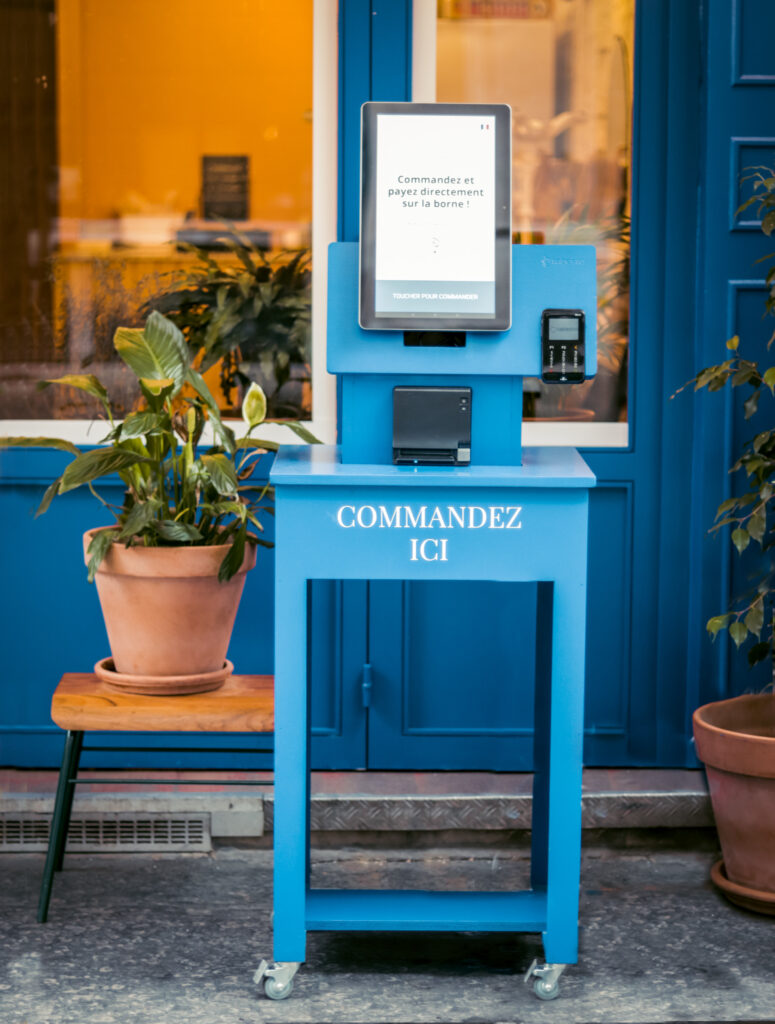
To choose, it will be better to buy the equipment if the cash is there rather than rent it via a banking organization like LOCAM, because in the long run, it will cost you very expensive and in addition, you will have to remember to send the famous registered letter in order to end the leasing otherwise you will be automatically rehired, which is almost like a scam, also practiced by Nespresso elsewhere. Indeed, the job of a restaurateur is not to send registered mail reminders but to cook and serve food.
Fortunately, Tabesto can very kindly take care of this administrative aspect at your request, and it is remarkably kind of them to do so., unlike Nespresso which preferred to say nothing, forcing the restaurateur to sign on for another year.
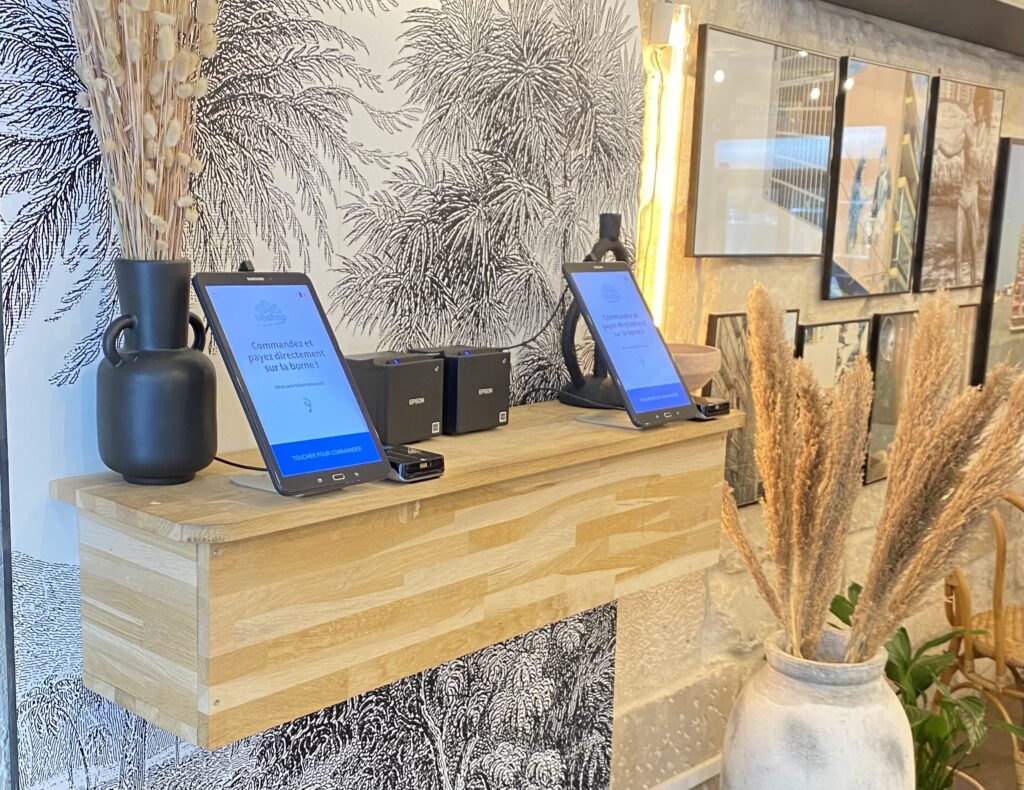
Price-wise, Tabesto generally costs around €70/terminal/month (but this can vary depending on the number of terminals used), which is largely correct.
The +:
- a well-polished design on the client side;
- a system used by most restaurateurs, and therefore a habituation on the part of customers regarding the use of their ordering;
- a connection with most cash register systems like Zelty or Tiller;
- a caring accounting department at Tabesto;
- Promo Code functionality finally integrated in 2024;
- No built-in loyalty, but you can plug Tabesto into a loyalty app like Pongo for example.
THE - :
- Responsive but sometimes overwhelmed customer support. Edit 2025: during the year 2024, Things have improved remarkably since then, it must be recognized. This point is therefore no longer a weak point a priori at Tabesto, which has improved technical support and resolved a lot of the bugs that were a stain, which brings us to the next point.
- Many bugs (before 2024 therefore): tedious TPE terminal connection, timeout at the end of the order process that does not work, payment refused even though it has gone through, which leads to the customer having to pay twice and which leads to customer complaints by email afterwards, etc. Edit 2025: Over the past year or so, the bugs in Tabesto have reduced considerably, so it was important for me to update this article.
- A latency time between the order and arrival at the checkout that is too long, especially with the Tabesto / Zelty connection, and this is a really important point when there is a rush or paradoxically when there is only one customer, because the delay between the confirmation of the order and its arrival at Zelty can sometimes cause discomfort between the seller and the customer;
- Too long a latency between ordering and printing the ticket, which means that customers never wait for their ticket, leaving it to the next customer. And since the ticket printing is no longer automatic, too long a latency between order confirmation and the end screen;
- A much, much too long latency time between the end of a command and the return to the terminal homepage;
- The obligation to give one's name at the beginning of the process, and not at the end of the customer process, which for me is almost a deal breaker, because it creates a friction stage at the beginning of the customer journey, when sometimes we just want to look at the menu and we don't yet know if we're going to go through with it;
- Generally speaking, a slow and tedious customer journey;
- A heavy system that runs under wifi with installation of a Tabesto router, therefore easily bugged in case of unstable wifi. Edit 2024: since then, this point has been improved with the possibility of an Ethernet installation.
- A somewhat archaic menu editing dashboard: too many limitations on the weight of a photo (resolved since 2024), loading time too long, no photo thumbnail in the product list, no multi-site management so one menu per restaurant, and no responsive version for mobile so it is impossible to make a price change from a smartphone.
My final opinion on Tabesto: a good pioneer, who went through a very complicated phase, but which has recently improved considerably, which prompted me to update my article.
The Zelty control terminal
The cash register software Zelty also offers its own tablet system, which runs on iPad, for an inexpensive subscription of €39, to which must be added the subscription to the TPE solution, of €20 excluding VAT / month / TPE. And against all expectations, as crazy as it may seem, the Zelty terminal is probably the best that has been done in terms of fluidity and customer experience, while being full of bugs.
In theory, this is the best terminal system in my opinion, after testing more than ten solutions, although it has undeniable weaknesses that I will describe below.
To benefit from the Zelty kiosk system, you will of course need to have the Zelty checkout system, but if this is your case, know that this solution is paradoxically the most fluid, the simplest and the most appreciated by customers. And for good reason: it is in fact its totally "basic" aspect that makes this solution the most effective. In practice:
- It is the one that causes the least friction from customers;
- The iPad ordering system is extremely efficient, intuitive and reassuring for the customer;
- In the era of vertical format hegemony, the horizontal format of the terminal is super convincing;
- The sequences are super fluid;
- The order literally takes 5 seconds for the customer who already knows what he wants.
What's remarkable is that it's precisely the fact that this solution was created with minimal resources—without wanting to devalue the great work that was done—that makes this terminal—a priori—the most effective. But there's still a but, and we'll get to that.
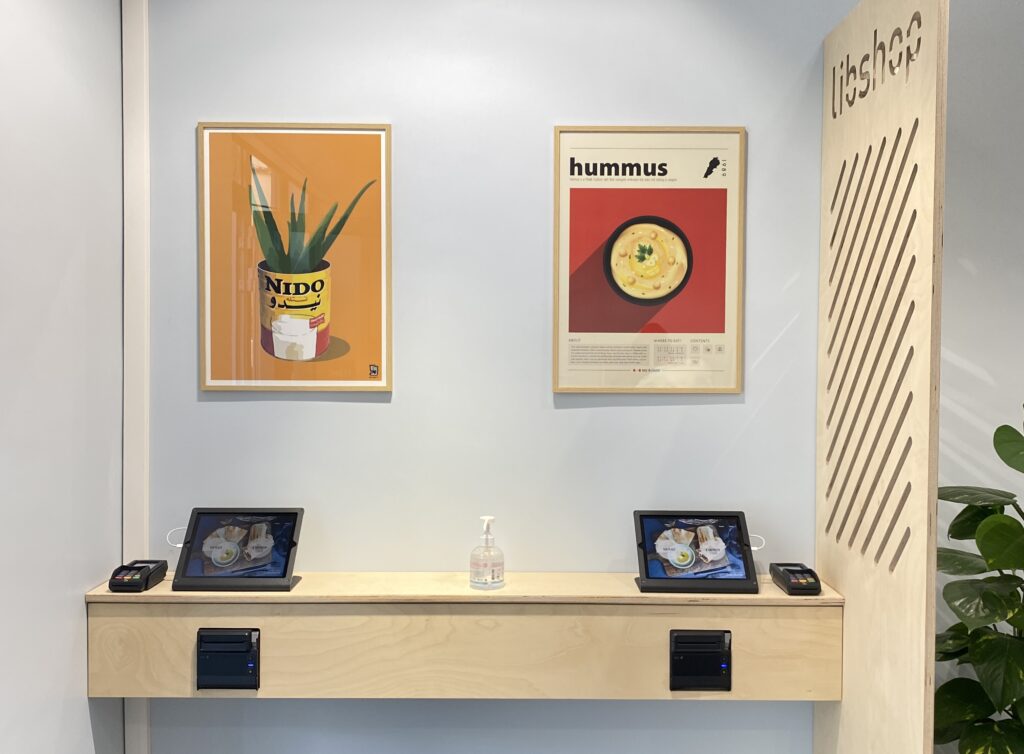
On paper, for those who have the Zelty checkout, it is therefore the ideal tool, since the use of the terminal by the same service provider makes it possible to avoid the interaction of several service providers, with the misunderstandings that this can cause, the additional costs, the cumulative interlocutors and a fluidity that is at least relative. And this is indeed, in the era of digitalization and the economic crisis, what we will tend to look for more and more as customers: reduce service providers, streamline processes and improve the customer experience.
While the Zelty terminal meets almost all of the conditions mentioned below, it unfortunately wasn't without a hitch, as I'll detail in the negative aspects just after.
The +:
- Unrivaled fluidity when taking orders (finally!);
- In theory, good value for money, and I mean in theory, you will understand right after;
- Using an ethernet connection (VS Wifi for Tabesto, although Tabesto now offers wired, after imposing bugs on their customers for years), which avoids problems related to unstable wifi, so again in theory, it's much more pro, even if in fact,
it's buggyit was buggy for more than 3 years, though (we'll get to the negative aspects); - A single place to modify the menu, in Zelty, which avoids many complications, and this is the major point, because making a modification in a single place saves time and especially errors. On Tabesto, you must first change the product in question on Zelty (at the base), then modify it in Tabesto for the restaurant concerned, then modify it in each tabesto menu for each restaurant concerned, and finally launch a synchronization of products between Tabesto and Zelty, in other words an obstacle course, especially when you have to manage several restaurants, although the "Catalog" functionality of Zelty has improved things.
THE - :
- Very little support for installation.
- Unexpected bugs during payment: for more than 3 years, I personally had daily cases of orders falling into a black hole, probably because of micro-internet cuts (this is in any case the reason given by Zelty, which the Internet service provider denies). As a result, the order was validated on the customer side but never arrived on the cashier side, which not only forced the cashier to find a solution with the customer to ask him if the order had been paid or not, and to ask him again for the items in his order, but in addition, it was necessary to restart the terminal app to unblock the situation for the following customers (which is absurd), a totally unmanageable situation in the event of a rush;
- Worse still, as the order placed at the terminal never arrived at the cashier, and no receipt was printed, the customer waited in the void for his order, sometimes more than 15 minutes without anyone taking care of him. In the event of a bug, it would be enough for the order to go into a queue, before being sent back to the cashier after a delay, but Zelty unfortunately did not manage to resolve this bug for several years, despite their good intentions.
- A visible promo code functionality but which was never functional (what a shame);
- No customer recognition or loyalty;
- Product description display problem, the description is never displayed in full for unique products, which is again eliminatory since the customer is not informed of all the ingredients of the product. It would be enough to open a pop-up for each individual product, but despite this suggestion, that does not seem to be on the agenda for Zelty;
- The “out of stock” functionality does not work unless you restart the terminal app each time it is out of stock, which is, to say the least, disastrous. Imagine that you are out of stock, you deactivate a product, and your 10 terminals continue to display the product until the next “burst” of customers. Total rubbish;
- The systematic printing of tickets until the beginning of 2025, despite several reminders from me to stop this.
- Friendly support, but unfortunately it was unable to resolve the listed issues, and customer relations sometimes bordered on amateurism.
Conclusion: if you are in a small space, you are looking for an inexpensive backup solution and you are resourceful, these terminals will do the trick at first, except that you will have to pay for iPads (very expensive), and once you are under the cold shower of the incalculable number of bugs, the salesperson who was initially very motivated to sell you this whole expensive solution will be much less talkative later on, and lacking in solutions. And of course, despite the bugs, the terminals will be billed to you every month.
Edit 2024: Zelty seems to have abandoned the development of their solution, while strangely maintaining the billing for it to its rare customers who use it. Moreover, the Zelty terminal was paradoxically the most functional, probably the best, because it was the most fluid and the simplest, and the most appreciated by both customers and restaurateurs, but it would seem that Zelty is not aware of this...
Edit 2025: Against all odds, Zelty has finally made an unexpected update, adding a ticket printing feature on demand – hallelujah – and according to my first tests, it seems that the famous bug of not sending the order to the terminal is resolved, or at least almost resolved, because I haven't encountered this bug for a while, fingers crossed!
We would like to see the same awareness from Zelty for their QR Code menu functionality at the table, which, like the kiosks, seems on paper to be the best solution for their customers, but which presents eliminatory anomalies, such as the fact of requesting a ton of information from the customer seated at the table via a form, thus pushing restaurateurs into the arms of other startups and therefore towards a multiplication of service providers, an increase in costs and commissions, and complications that restaurants would have been happy to do without.
The Innovorder terminal: the most serious player
Innovorder was also one of the first players to position itself on ordering terminals accessible to small and medium-sized businesses, and from what I remember, the support was much more serious than with a player like Tabesto, or in the case where you had to be completely autonomous on the Zelty side.
I was struck by the seriousness of their teams when I visited their premises, and they were the most serious in the way they explained their product, showed their statistical and analysis tools, and their ambitions.
The +:
- an all-in-one solution with cash register software, which avoids laborious mappings (see Tabesto X Zelty);
- hyper-pro terminal designs, which resemble a McDonald's.
- unrivaled fluidity;
- the ability to easily personalize the card;
THE - :
The only limiting side that I see but it is not one because the quality of the pay is the higher price than Tabesto, but if everything works and better, then it is worth it, provided you have a certain volume (at least 60 to 80 orders/service for example).
For my part, I was only able to see the solution in demo and never on site, so I cannot give my opinion on the product, but it seems that customer feedback is positive on their ordering solution.
TastyCloud ordering terminal: the classiest
TastyCloud was also one of the first players to position itself in restaurant ordering systems, and it initially positioned itself on brands that were a little more premium than Tabesto, which was more focused on fast food concepts.
As a result, TastyCloud tablets display the menu horizontally rather than vertically, and seem to prioritize the user experience and the increase in the average basket through a well-designed product suggestion during the customer journey.
I have not had the opportunity to test this solution on site, but here is what emerges from my research on the solution.
The +:
- Synchronization with most cash register software;
- No automatic printing of the ticket, unlike Zelty which prints everything for nothing, and uses a lot of paper in a vacuum (hello ecology), and Tabesto which "forces" the user to enter their email to receive a ticket. an impression that has no value;
- A premium design for a better presentation of products, highlighting the restaurant menu in the best possible way;
- A multilingual map;
- Quality photos, unlike Tabesto which forces compression to really small sizes;
- Personalized suggestions;
- The invitation to leave a review by the customer via the tablet.
Having not been able to actually test the tool, I cannot speak about the disadvantages or the bugs, but TastyCloud seems to be the service provider which received the best customer review score. If you have a serious restaurant, and not a concept of donuts on the beach, I advise you to favor this solution rather than a Zelty or a Tabesto, otherwise you risk damaging your credibility.
Belorder order terminal: the outsider
Belorder positions itself as an ultra-serious outsider with very interesting cross-functional solutions. For now, I've only been able to see the demo, but I'm going to test the solution soon, which integrates both the ordering terminal and the online ordering part. In short, it seems to be the most advanced terminal tool.
The +:
- Not necessarily more expensive than another despite a solution that seems very successful;
- A great design and a smooth user experience;
- Advanced statistics;
- A customer pooling with the “online ordering” part, which I personally use for my restaurants and which is the best online ordering solution in my opinion;
- A loyalty tool;
- Simple connection with cash register software like Zelty.
THE - :
- For the moment I don't see any, I'm waiting to test, which is planned in the coming days because I'm at the onboarding stage. But so far, everything is very professional on their side and having tested their terminals at Pokawa, it seems to work really well.
The other actors
If you know of any others, don't hesitate to share them in the comments and I won't hesitate to add them to the article!
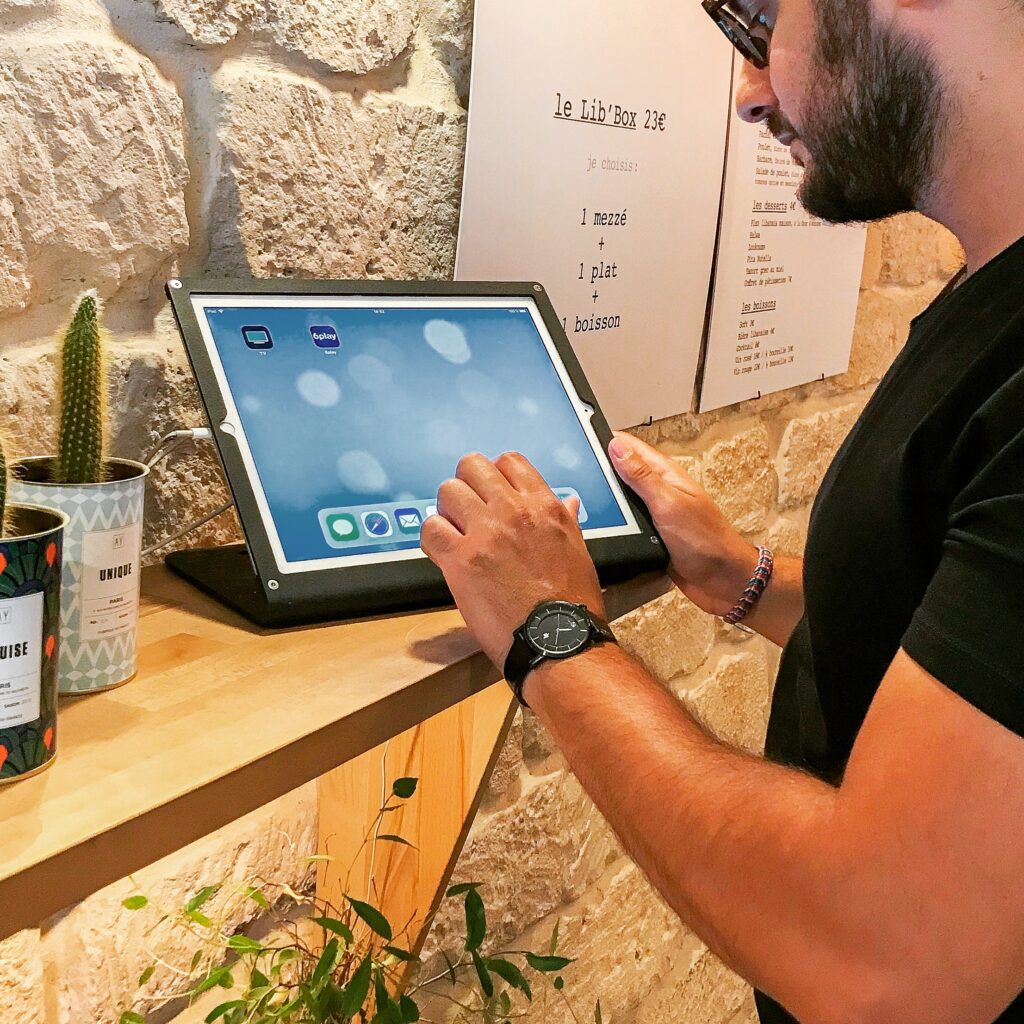


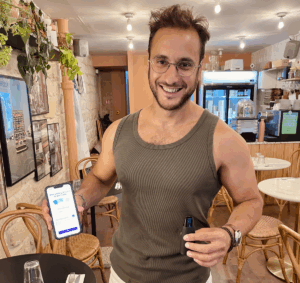


3 Responses
Good morning,
Nice article.
If you are present at food hotel tech in Paris, come and test our restomax terminals. In addition to being pretty and fluid, they include loyalty, promotions, cashless etc…
Good morning,
Thanks for your feedback. I won't be there this year, but I'm keeping your solution in a corner of my mind which seems to be very complete 🙂
Thank you 🙂
We are a publisher of order terminals, cash registers, qrcode, click & collect & ordering apps. Everything is managed with the same back office and the same KDS (kitchen screen) and is connected to the platforms (ubereat, deliveroo, takeaway justeat).
Thanks to this complete ecosystem, we have convinced more than 4,000 points of sale to use our solutions (www.restomax.com).
And we have 10 local partners in France who resell and install our solutions in all regions.